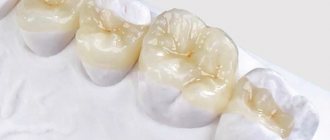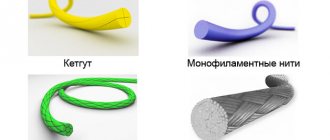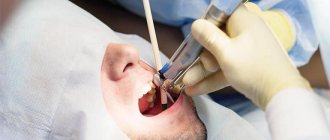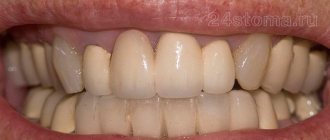The seventh teeth (second molars according to the dental classification) are located in hard-to-reach places. They are often lost due to poor hygiene. Also in this area there are high chewing loads, which accelerates destruction. To restore missing teeth, implants and dentures are used. When removing sevens, a terminal defect often occurs, since wisdom teeth are often removed at the eruption stage or do not erupt at all. In such cases, implantation is the best solution, since it guarantees reliable fixation, restoration of chewing function, and long service life.
Causes and consequences of losing the seventh teeth
Tooth loss usually occurs due to chronic diseases. Sevens are at risk - they are subject to heavy loads when chewing food, and their location does not allow for high-quality hygiene at home. Together, these factors lead to the rapid development of caries, pulpitis and crown destruction. Following the crown, inflammation moves to the root, periodontitis occurs, the formation of granulomas and cysts. If not treated in a timely manner, the inflammatory process spreads over large areas, which leads to the removal of the source of infection. Other reasons:
- periodontitis;
- jaw injuries;
- bone atrophy due to age-related changes;
- congenital anomalies.
The loss of even one unit of dentition leads to the following consequences:
- malocclusion - voids in the dentition lead to a displacement of neighbors towards the missing unit, while the jaws will no longer close as tightly as before;
- diseases of neighboring teeth - when tilted towards the defect, the necks become exposed, sensitivity and inflammation occur;
- diseases of the digestive system - food is not chewed properly, pathologies of the stomach and pancreas develop;
- bone atrophy - due to root loss, the load on the jaw decreases and it becomes thinner;
- change in appearance - tired appearance due to sunken cheeks and wrinkles.
What is the tooth extraction procedure?
Removal or extraction is a dental surgical operation during which a tooth is removed from the alveolus of the jaw in whole or in part. In the first case, the crown and root part are removed, in the second, resection or hemisection is performed while preserving the dental unit.
- Complete removal - removal of the crown and roots after separation of the soft tissues and rupture of the ligaments. It is indicated in cases of loosening, significant tooth decay, jaw fractures, or the need for orthodontic (for example, braces) or orthopedic treatment.
- Resection is the excision of the apex of the affected root; it is performed when a granuloma or cyst is detected on it. Access is carried out microsurgically through the soft tissue and jaw bone in the projection of the inflamed area or neoplasm.
- Hemisection is the amputation of one of the roots of multi-rooted (chewing) teeth along with the adjacent part of the crown. It is used for inflammatory processes, the impossibility of tooth-preserving treatment, pathological features or root fractures.
Complete tooth extraction
Recovery methods
You can restore sevens by:
- fixation of a dental bridge;
- installation of a removable denture;
- implantation
A bridge in the absence of one tooth consists of three crowns. The outer ones are fixed on the supporting teeth, and the middle one compensates for the lost unit. Since the seventh tooth is usually the end tooth, there is nothing to attach the permanent bridge to. In this case, removable structures are used.
Removable dentures are fixed on the teeth on one side, and glued to the gums with a special gel on the other. This is an inexpensive option, but unreliable - the fixation of the prosthesis is unstable and does not provide functional qualities.
Implants completely imitate the structure of the tooth and are the best solution to the problem. A titanium root is screwed deep into the jaw, and a crown is placed on top. Neighboring units of the dentition are not involved in any way. An artificial tooth is no different from a natural one and takes the same chewing loads.
- Dental bridge
- Removable denture
- Implantation
When does a tooth need to be removed?
Removing a wisdom tooth or any other tooth is a last resort measure, used only when it is not possible or advisable to preserve the dental unit. In this case, extraction can be carried out either urgently, on the day of treatment, or delayed - according to an individual schedule.
Indications for emergency removal
It is urgent to remove a tooth in the following cases:
- extensive carious lesions, impossibility or inappropriateness of caries treatment;
- inflammatory diseases of periodontal tissues, odontogenic sinusitis;
- pathological processes accompanied by acute pain, fraught with serious complications;
- injuries to the teeth and jaw (fractures).
Indications for the planned procedure
Removal is delayed if:
- teeth become loose due to weakening of the ligaments and periodontitis;
- there are supernumerary, impacted (unerupted) or dystopic (severely displaced) dental units;
- orthodontic treatment was prescribed to correct the bite (braces);
- the tooth interferes with prosthetics, including implantation;
- The baby tooth prevents the eruption of the molar tooth.
Implantation stages
Implant installation is carried out using the classical method. Includes stages:
Preparatory
Examination and sanitation of the oral cavity, assessment of the condition of bone tissue, examinations, including x-rays and consultation with a therapist. It takes from one to two days (if no contraindications are identified and no sanitation of the oral cavity is required) to a couple of months (if obstacles to the operation are found).
Bone tissue augmentation
Optional step. It is necessary for long-term absence of a tooth, when the jaw at the site of the defect is atrophied and needs to be restored. The material is planted into the alveolar process and waited until it fuses with the bone. The operation itself lasts 2-3 hours, but the recovery period takes up to six months. In cases of minor bone loss, osteoplasty is performed simultaneously with the installation of an artificial root.
Implant installation
The gum is surgically removed and a hole is made in the bone for an artificial root. After installing the implant, a plug is attached on top, and the mucous membrane is sutured. Engraftment up to 6 months.
Installation of the healing abutment
The gums are opened and a former is placed on the titanium root for 10-14 days to create the contours of the gums for the future crown.
Fixation of permanent prosthesis
The former is replaced with an abutment (an adapter between the crown and the implant). The crown is installed using previously taken impressions.
Features of implantation of the 7th upper tooth
Due to the anatomical features of the upper and lower jaws, the timing of implantation differs.
The upper jaw is subject to less stress when chewing. The bone tissue is looser compared to the lower row. Therefore, the implant takes 1-2 months longer than from below. Above are the maxillary sinuses, the infraorbital foramen and the facial nerve. If the implant is inserted incorrectly, there is a risk of damage, which increases the complexity of the procedure.
In case of sinusitis, sinus cyst, inflammation of the nasal mucosa, surgical intervention to implant a titanium root is not performed until the disease is eliminated.
If the upper molar is missing for a long time, the patient is indicated for a sinus lift. The procedure compensates for the lack of bone tissue by raising the bottom of the maxillary sinus and filling the space with synthetic material. The operation is performed open or closed.
In the first case, the procedure is carried out in two stages. The doctor builds up the jawbone, and after the osteoplastic material has fused with the tissues, an artificial root is implanted.
A closed sinus lift is combined with implant installation. The technique is less traumatic and reduces the duration of treatment. Loading of the artificial root with a crown is carried out after osseointegration.
Is it possible to use express methods for sevens?
Express implantation can be performed in two ways.
Option 1 - place a crown right away
Implantation Immediate Load - instant loading of a titanium root with a crown. In 3-7 days, the patient completes the full course of treatment and receives a new tooth. But this protocol is not suitable for sevens. Usually there is not enough bone tissue in case of loss of the last tooth. And implantation with an immediate load is carried out only when there is a sufficient amount of bone. In case of atrophy, rapid loading does not provide reliable fixation of the titanium root; it cannot be guaranteed that the implants will last the entire period promised by the manufacturer.
Even in the case of ideal conditions with a sufficient amount of bone tissue, it is not recommended to immediately load the seven implant with a crown. The second molar is actively involved in the chewing process; displacement during chewing is possible.
Option 2 - place an implant immediately after tooth extraction
The implant is installed in the hole immediately after the seven is removed. In this case, the healing stage after extraction is skipped, which saves the patient 4-5 months. For 7 teeth, this method is allowed only if there is an adequate amount of bone tissue, planned rather than emergency tooth extraction, the absence of cysts and granulomas on the root, and gentle extraction without damaging the alveolar process.
Is it possible to place a crown right away?
A one-stage technique with instant loading involves the rapid restoration of lost teeth - the titanium root is loaded with a temporary crown for a maximum of 3 days after surgery. But this method is only suitable for replacing teeth that do not take part in chewing (premolars - fours, fives).
This method is not recommended for second molars. When eating, the sevens are subject to stress, which leads to displacement of the implant. Therefore, the crown is installed after healing, when the root has firmly grown into the bone. Until osseointegration is completed, the patient wears a lightweight removable denture. It is attached to adjacent teeth and does not load the implant. If the patient insists on immediate installation of a crown, the clinic does not provide a guarantee for the implant system.
If the patient insists on immediate installation of a crown, the clinic does not provide a guarantee for the implant system.
Price
The cost of installing an implant in our Center is standard. Pricing is formed on a turnkey basis. There are several ready-made treatment options. For example, using Nobel Biocare PMC implants, restoring a seven is 20 thousand cheaper than installing a Nobel Biocare Conical Parallel CC. The first ones are used for weak bones, the second ones - of the new generation, for strong ones.
The operation takes place in two stages. At the first, the price includes the procedure itself, the implant and plug, pain relief, consumables, postoperative X-ray examination and CT scan after eight weeks. The application and removal of sutures are also taken into account when determining the cost.
At the second surgical stage, the price list includes painkillers, antiseptics, opening and removal of implant plugs, fixation of gum formers, and consumables.
In the “implantation” case, the cost of surgical treatment does not include crowns. The price depends on the manufacturing method and type of fixation.
Our Center has its own laboratory, where only all-ceramic crowns are manufactured using the Zirkonzahn Schule method. You can order production at the Swiss PROCERA plant, but you will have to wait longer.
The cost of the case does not include sanitation, sinus lift, osteoplasty and temporary prostheses until the implants are healed.
Guarantees
The Center for Private Dentistry “Doctor Levin” has a guarantee program. The patient of the clinic will receive a guarantee for:
- implant;
- surgery;
- sinus lifting and osteoplasty;
- prosthetics.
Only Lifetime on Nobel Biocare issues a lifetime warranty on the implant; other companies usually provide 25 years.
The warranty provides a year of free service for implantation and two years for all types of treatment. The contract is valid subject to systematic medical examinations and proper care.
Contraindications
Even if a wisdom tooth (or another) hurts, removal may be contraindicated. Contraindications are divided into absolute (complete prohibition) and relative, when the operation can be performed under certain conditions. The first include blood diseases accompanied by reduced blood clotting (hemophilia, for example), oncological processes in the jaw area, as well as a recent history of a heart attack or stroke.
Relative contraindications include any acute conditions and pathological processes in the body (extraction is allowed after the exacerbation has stopped). The list includes:
- renal failure;
- cardiovascular pathologies (hypertension, arrhythmia, angina pectoris);
- infectious inflammation of any localization;
- stomatitis;
- blood diseases (agranulocytosis, leukemia);
- radiation sickness;
- circulatory disorders;
- cancer at the stage of therapy.
There are additional restrictions for women. Thus, it is not recommended to remove teeth during menstruation (due to decreased blood clotting), as well as in the first and last trimesters of pregnancy.











